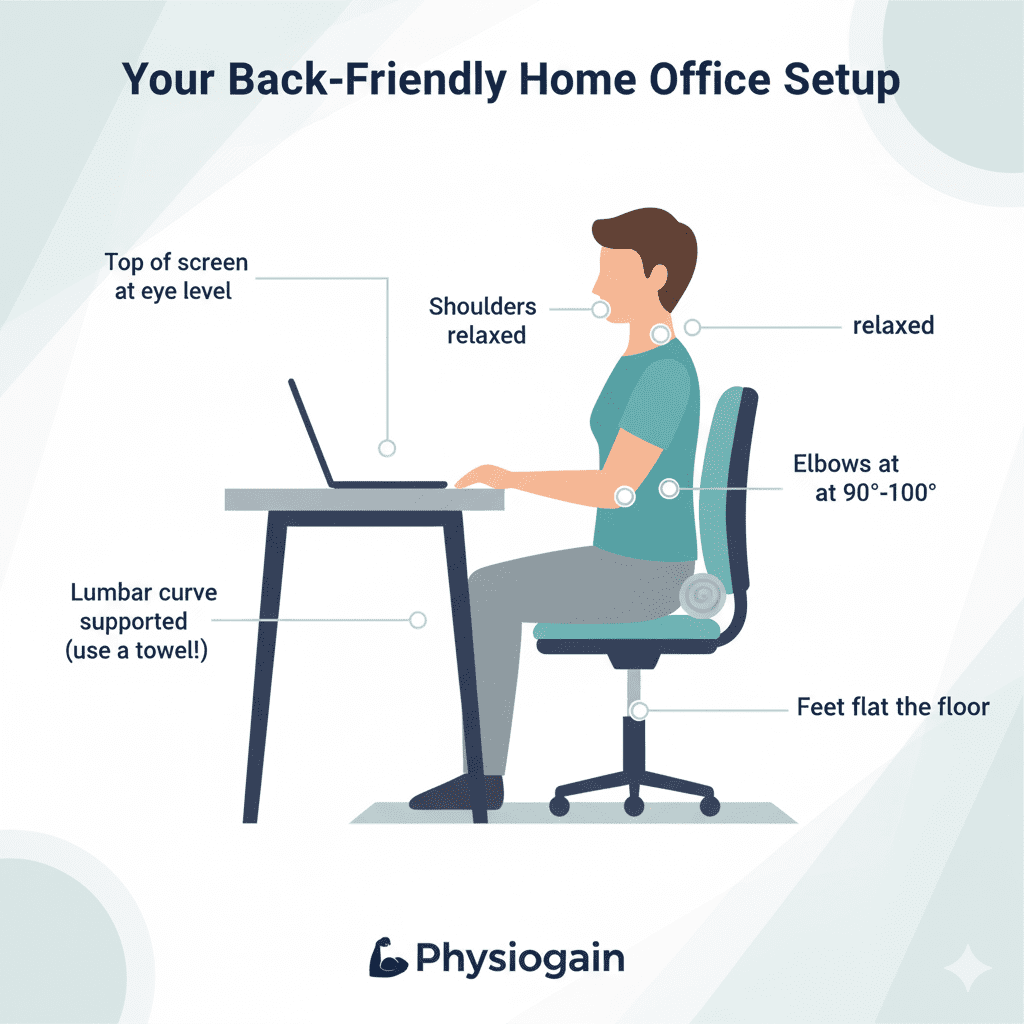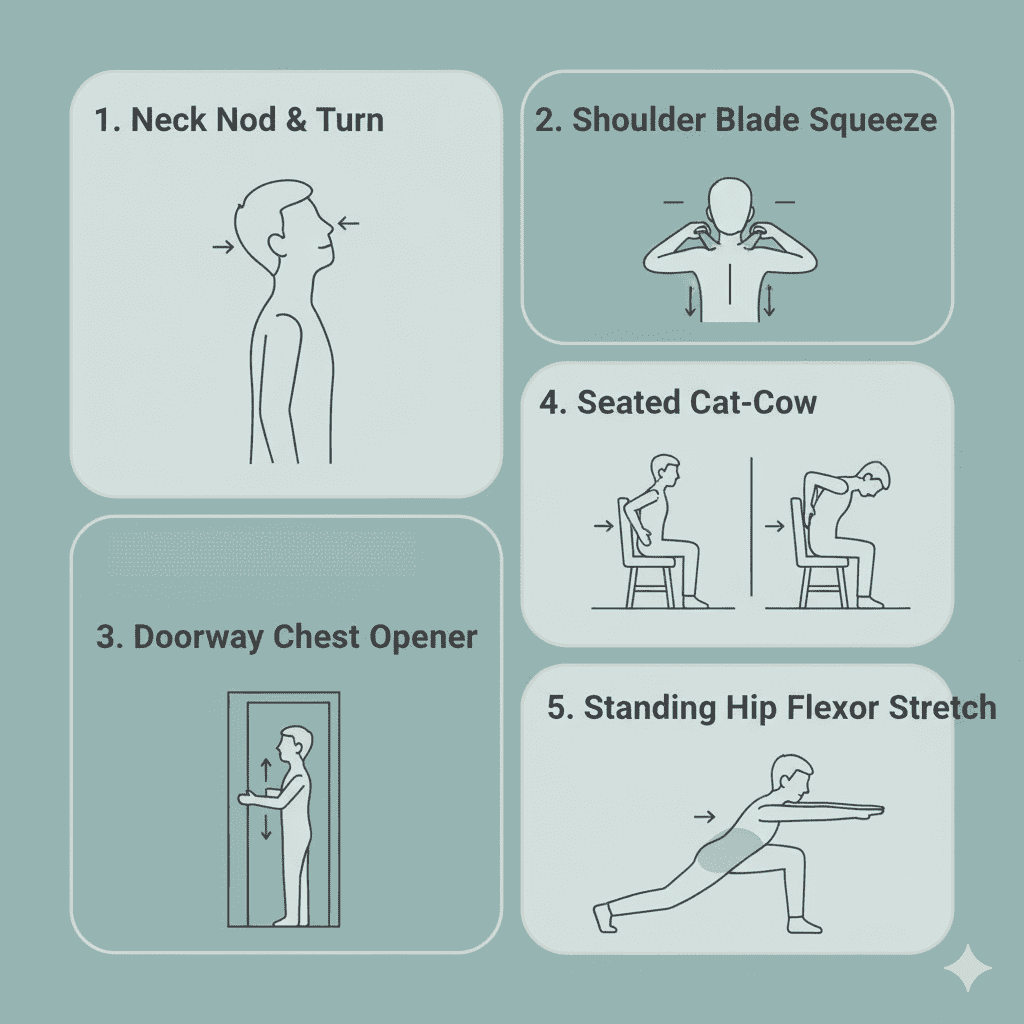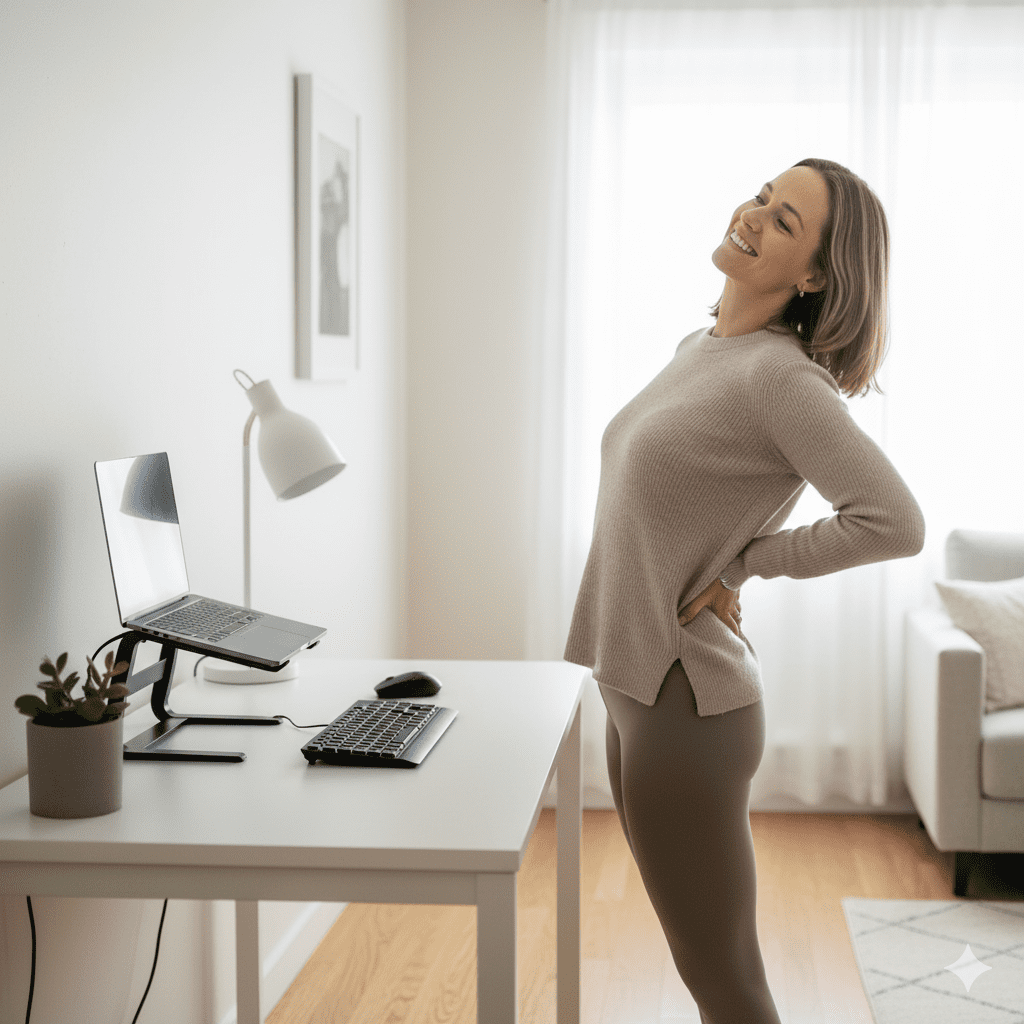Remember when working from home sounded like a dream?
Flexible hours, no commute, sweatpants as the official office wear. It was the promised land of work-life balance.
Fast forward, and for millions, that dream has morphed into a daily battle with an unexpected, relentless enemy: desk-bound back pain.
Your “office” might be the kitchen table, the sofa, or a hastily arranged corner in your bedroom. The lines between work and life have blurred, and your body is paying the price.
Your shoulders feel like they’re in a permanent shrug, creeping slowly towards your ears. Your neck carries a deep, persistent ache that no amount of rubbing can soothe. And your lower back… well, let’s just say it’s staging a silent, aching protest that gets louder with every passing hour.

If you find yourself constantly shifting in your chair, groaning when you stand up, and feeling a sense of dread about the long hours of sitting ahead, you are definitely not alone. The constant, nagging discomfort is more than just an annoyance; it’s a thief of focus, a drain on productivity, and a shadow over your well-being.
But here is the most important thing you need to hear: this discomfort is not your new normal. It is not an inevitable price you have to pay for the flexibility of working from home.
I vividly remember a time when my sharp lower back pain started dictating my day. My mornings were filled with dread, knowing I had eight hours of sitting ahead of me. One specific day, I realized I couldn’t even bend down to tie my shoes without a jolt of pain, and that was the turning point that led me to discover the power of micro-movements and proper ergonomics.
This guide is your comprehensive toolkit to fight back and reclaim your comfort.
We’re here to help you transform your work from home back pain into a thing of the past. We’ll dive deep into the science behind the pain, provide simple ergonomic adjustments, teach you effective posture correction exercises, and share smart habits recommended by physiotherapists. This is your roadmap to a pain-free, productive WFH life.
The Silent Culprit: Why WFH Magnifies Back Pain
Our bodies are masterpieces of engineering, designed for one fundamental purpose: movement.
They crave variety—walking, bending, reaching, twisting. This dynamic movement keeps our joints lubricated, our muscles balanced, and our circulation flowing.
Prolonged, static sitting is the antithesis of this design. It forces our bodies into a fixed, unnatural position, putting continuous, low-grade strain on some structures while causing others to completely switch off.
Working from home has, for many of us, become a perfect storm for back pain.
The common pitfalls are now part of our daily landscape:
- The unyielding dining chair that offers zero lumbar support.
- The laptop perched on a coffee table, forcing our neck into a permanent downward gaze.
- The deceptively comfortable sofa that feels great for five minutes and wreaks havoc over five hours.
We’ve also lost the natural, built-in movement breaks of a traditional office environment. There’s no walking to a colleague’s desk, no stroll to the water cooler, no commute to decompress and change our posture. It’s often just you, the screen, and hours of uninterrupted stillness.
Think of your spine like a complex suspension bridge. It has a natural, beautiful S-curve designed to distribute weight evenly. When you sit slumped for hours, you’re essentially forcing that bridge into a C-shape. The ligaments, which act like supportive cables, slowly stretch and deform under the constant load—a process called “ligamentous creep.”
Simultaneously, a muscular civil war breaks out.
- The Tight Muscles: Your hip flexors (from being constantly bent), chest muscles (from hunching forward), and hamstrings get short, tight, and overworked.
- The Weak Muscles: Your glutes (your powerful hip extensors), your deep core stabilizers, and the crucial muscles between your shoulder blades become lazy, weak, and “inhibited.” They essentially forget how to do their job.
This imbalance pulls your entire structure out of alignment. The weak muscles can’t support you, so the tight muscles take over, pulling your posture further into that slump. This is the very definition of desk-bound back pain. Add in the mental stress of deadlines and long days, which causes us to unconsciously tense our shoulders and neck, and you have the perfect recipe for chronic discomfort.
Your Ergonomic Arsenal: Building a Back-Friendly Home Office
“Ergonomics” sounds technical and expensive, but it doesn’t have to be.
Building an ergonomic home office is less about buying a $1,000 chair and more about using clever, simple adjustments to make your existing setup work for your body, not against it. The goal is to create an environment that supports a neutral, relaxed posture. Let’s break it down.

The Chair is King (or Queen)
Your chair is your command center. Getting its position right is the first and most critical step.
- Feet Firmly on the Floor: Your feet should be flat on the ground, or on a footrest if they don’t reach. Why? This provides a stable base for your entire body. When your feet are dangling, your body is unstable, and you tend to slide forward into a slouch, putting immense pressure on your lower back.
- Knees at a 90-Degree Angle: Your thighs should be roughly parallel to the floor, with your knees at or slightly below the level of your hips. Why? This position minimizes strain on your hips and lower back and ensures good circulation to your lower legs.
- Support Your Lower Back: Sit back in your chair so your spine is resting against the backrest. There should be support for the natural inward curve of your lower back (the lumbar curve). If your chair lacks this, don’t rush to buy a new one. DIY Solution: Roll up a bath towel or grab a small cushion and place it in the small of your back. This simple trick is incredibly effective for maintaining your spine’s natural S-curve and providing
sitting pain relief. - Relaxed Shoulders and Arms: Your elbows should be bent at a 90 to 100-degree angle, resting comfortably close to your body. Your shoulders should be relaxed, not hunched up towards your ears.
Screen Savvy: Defeating “Tech Neck”
Where you place your screen dictates the posture of your head and neck, which in turn affects your entire spine.
- Top of Screen at Eye Level: Position your monitor or laptop screen so the top of it is at or just below your eye level. Why? This is crucial. The human head weighs about 10-12 pounds. For every inch your head drifts forward from a neutral position, it adds about 10 extra pounds of force onto your neck and upper back muscles. A screen that’s too low forces you into this “tech neck” posture, leading directly to strain and pain.
- Arm’s Length Away: Your screen should be about an arm’s length away from your face. This prevents you from leaning in and straining your eyes and neck.
- Laptop Users, Listen Up: If you work primarily from a laptop, investing in an external keyboard and mouse is the single best ergonomic decision you can make. Why? A laptop’s screen and keyboard are attached, making it impossible to position both correctly at the same time. Using an external keyboard and mouse allows you to place your laptop on a stack of books or a stand to get the screen to the correct height, while keeping your hands and arms in the correct ergonomic position.
The Power of the Periphery
The small things matter. How you arrange your immediate workspace can have a big impact.
- Mouse in Close: Keep your mouse close to your keyboard. Why? Constantly reaching out to the side for your mouse puts repetitive strain on your shoulder, arm, and wrist.
- Keep Items in Reach: Place frequently used items like your phone, notebook, or water bottle within easy arm’s reach to avoid awkward twisting and reaching.
- Consider a Standing Option: You don’t need a fancy standing desk. You can test the benefits by working at a high kitchen counter for a portion of the day. This simple change in position engages different muscles, improves blood flow, and gives your “sitting” muscles a much-needed break.
Move It or Lose It: Essential Exercises & Stretches for Desk Warriors
Even the most perfect ergonomic setup can’t defeat the negative effects of being static. Movement is the antidote.
Think of these not as a workout, but as “movement snacks”—quick, easy, and satisfying breaks that you can pepper throughout your day to reset your posture and relieve tension. Aim to do one or two every 30-60 minutes.

Talk to us before doing any exercises, this is only for educational purpose.
1. The Neck Nod & Turn
- Why you’ll love it: This provides immediate relief for a stiff, tight neck, melting away the tension from staring at a screen.
- How to:
- Sit tall in your chair, looking straight ahead.
- Gently and slowly tuck your chin towards your chest, as if you’re making a double chin. You should feel a gentle stretch at the back of your neck. Hold for 3-5 seconds.
- Return to the start position.
- Now, slowly turn your head to look over your right shoulder. Hold for 3-5 seconds.
- Return to the center and repeat on the left side.
- Physio’s Pro-Tip: Keep the movements slow and gentle. Never push into sharp pain. Think about lengthening your neck as you move.
2. The Shoulder Blade Squeeze
- Why you’ll love it: This is the perfect anti-slouch exercise. It activates those sleepy upper back muscles and instantly pulls your shoulders back and down.
- How to:
- Sit or stand tall with your arms relaxed at your sides.
- Gently draw your shoulder blades together and down, as if you are trying to hold a pencil between them.
- Be careful not to shrug your shoulders up to your ears.
- Hold the squeeze for 5 seconds, then relax.
- Physio’s Pro-Tip: Focus on the “down and back” motion. This is one of the most important
posture correction exercisesyou can do.
3. The Doorway Chest Opener
- Why you’ll love it: This stretch is a direct counterattack to the “hunch” position. It opens up your tight chest muscles and feels incredible after hours of typing.
- How to:
- Stand in an open doorway.
- Place your forearms on the doorframe, with your elbows bent at a 90-degree angle (like a cactus or goalpost shape).
- Step one foot forward through the doorway and gently lean your body forward.
- You should feel a good stretch across the front of your chest and shoulders.
- Hold for 20-30 seconds, breathing deeply.
- Physio’s Pro-Tip: Keep your core engaged to avoid arching your lower back. You want the stretch to be focused on your chest, not your spine.
4. The Seated Cat-Cow
- Why you’ll love it: This movement brings mobility and blood flow back into a stiff spine. It’s like a gentle wake-up call for your vertebrae.
- How to:
- Sit at the edge of your chair with your feet flat on the floor and your hands on your knees.
- Cow: Inhale as you gently arch your back, push your chest forward, and look up towards the ceiling.
- Cat: Exhale as you round your spine, tuck your chin to your chest, and pull your belly button in.
- Flow slowly between these two positions for 5-8 repetitions.
- Physio’s Pro-Tip: Let your breath guide the movement. This adds a mindful, stress-relieving component.
5. The Standing Hip Flexor Stretch
- Why you’ll love it: Your hip flexors get incredibly tight from sitting, and this tightness can pull on your pelvis and be a major cause of lower back pain. This stretch provides targeted relief.
- How to:
- Stand up and take a step back with your right leg into a lunge position. Keep both feet pointing forward.
- Gently bend your front knee. Keep your back leg straight.
- Tuck your tailbone under slightly and squeeze your right glute. You should feel a stretch along the front of your right hip.
- Hold for 20-30 seconds. Repeat on the other side.
- Physio’s Pro-Tip: For a deeper stretch, raise the arm on the same side as your back leg straight up to the ceiling.
Beyond the Chair: Daily Habits for a Pain-Free Spine
Lasting relief comes from integrating small, healthy habits into your daily routine.

Hydration is Non-Negotiable
Your spinal discs—the little jelly-filled cushions between your vertebrae—are mostly made of water. When you’re dehydrated, these discs lose their plumpness and ability to absorb shock, which can contribute to stiffness and pain. Keep a water bottle on your desk at all times and sip throughout the day.
Practice Mindful Movement
Set a timer on your phone or computer to remind you to stand up, stretch, or simply walk around the room for one minute every hour. This is one of the most powerful WFH health tips. “Habit stack” by linking movement to another activity: every time you finish a call, stand up and do a chest stretch. Take phone calls while walking around your home.
Master Your Breath to Manage Stress
Stress and pain are deeply connected. When you’re stressed, you unconsciously clench your jaw and tense your neck and shoulder muscles. Try this simple belly breathing exercise: place one hand on your chest and the other on your stomach. As you inhale slowly through your nose, focus on making the hand on your stomach rise. Exhale slowly through your mouth. Doing this for just one minute can calm your nervous system and release muscle tension.
Myth vs. Fact: WFH Back Pain Edition
Myth: “My expensive ergonomic chair will fix everything.”
Fact: “An ergonomic chair is a fantastic tool, but it is not a cure-all. You can still slouch in the world’s best chair. Without incorporating regular movement, stretching breaks, and good postural habits, even the most advanced chair cannot prevent desk-bound back pain. Movement is always, always king!”
From Aching to Empowered: Your Path Forward
Conquering desk-bound back pain in your WFH life isn’t about one grand gesture or a single perfect solution. It’s about the power of consistent, small, and mindful changes.
From thoughtfully setting up your ergonomic haven, to embracing frequent movement snacks, to simply remembering to breathe and hydrate—each step is a powerful vote for your own health. These actions build upon each other, creating a strong and resilient defense against discomfort.
You have the power to change how you feel. You deserve to work comfortably, think clearly, and end your day feeling energized, not exhausted by pain. Take charge of your spinal health today and transform your WFH experience for good.
Disclaimer: The information in this article is for educational purposes only and is not intended to be a substitute for professional medical advice, diagnosis, or treatment. Always seek the advice of a qualified healthcare provider with any questions you may have regarding a medical condition.
Your Turn to Share!
If you’re still struggling with persistent work from home back pain, or you need personalized guidance to assess your unique setup and create a tailored exercise program, don’t wait for it to get worse. Our expert physiotherapists at physiogain.com are here to help. Book a virtual consultation today and let us help you achieve lasting relief and a healthier workday.